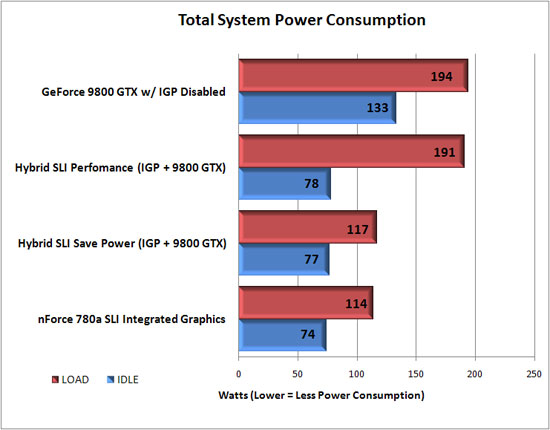NVIDIA Hybrid SLI and HybridPower Benchmarked and Explained
Power Consumption and Final Thoughts
Since the biggest feature of Hybrid SLI is the power saving feature known as HybridPower, we had to run some power consumption numbers. To measure idle usage, we ran the system at idle for one hour on the desktop with no screen saver and took the measurement. For load measurements we ran World in Conflict at 1024×768 with medium game settings to see what the peak Wattage was during game play. The peak Wattage was then recorded as the ‘Load’ value seen in the chart below. It should be noted that AMD Cool’n’Quiet was disabled in the BIOS for testing.

Results: Our power consumption testing showed that NVIDIA HybridPower technology is no joke! We were able to reduce our idle power by 55W, which is a 41% power reduction. In Performance Boost mode the system started off at 129W and then after four minutes changed over to Save Power mode and got down to 78W. A quick bump of the mouse and the system would change profile settings and the video card would power back on. One thing we did notice is that even though NVIDIA states the video card is fully turned off in Save Power mode, we did notice slightly higher power usage than when one was not installed into the system. It’s likely that just having the pair of 6-pin PCIe power connectors installed and the card in the system that it is consuming three Watts.

Final Thoughts and Conclusions:
NVIDIA Hybrid SLI and HybridPower technology are welcomed additions to the enthusiast computing scene and give consumers another reason to purchase NVIDIA platforms. Having the ability to turn off the discrete graphics at will is one of the coolest new features we have seen on a PC. It’s amazing that it took this long for someone to figure it out, but the time has finally come. NVIDIA Hybrid SLI technology was found to be pretty solid for being brand new technology.The slight performance decrease was expected, but the ability to use HybridPower seems to outweigh the performance hit. HybridPower technology is perfect as the World is now becoming green friendly and with so many people trying to conserve energy it is sure to gain NVIDIA some attention in the market place.
The only thing that would make HybridPower better from our perspective would be to have the system switch from Power Save to Performance Boost dynamically and reduce the time it takes to switch profiles. If the system is at an idle for four minutes in Performance Boost it will automatically change over to Power Save mode. This is a great start, but we are sure NVIDIA will improve upon this as time goes on. Other negatives we found during testing included the fact that only a very few motherboards and video cards support this technology. It was also interesting to see that NVIDIA started this technology with the GeForce 9800 GTX and GeForce 9800 GX2 graphics cards as the mainstream market should also love this new power saving feature. As time goes on NVIDIA will certainly bring Hybrid SLI and HybridPower technology to all price points and also over to Intel platforms when they release their next generation chipsets in Q3.
NVIDIA has a winner on their hands with HybridPower and it is exciting to see what the future holds for it. We hope that NVIDIA will stick with it and if they do it will force AMD/ATI and even Intel when they come out with GPUs down the road to follow suit. The winner in this scenario is partly the consumer saving a few bucks of energy and having a quieter system, but mainly the environment since less power is being used. It only makes sense that NVIDIA come out with these features first because their logo is green after all.

Legit Bottom Line: In case you can’t tell, we love Hybrid SLI and HybridPower! It might lower gaming performance by a small amount, but the power savings and noise reductions more than make up for it. Finally you can change between integrated graphics and discrete graphics on the fly.

Comments are closed.